
Hawaii is a U.S. state located in the Pacific Ocean. It is the only state outside North America, the only island state, and the only state in the tropics. Hawaii is also one of a handful of U.S. states to have once been an independent nation.
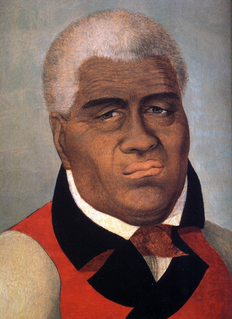
Kamehameha I, also known as Kamehameha the Great, was the founder and first ruler of the Kingdom of Hawaii. A statue of him was given to the National Statuary Hall Collection in Washington, D.C. by the state of Hawaii as one of two statues it is entitled to give.

The ʻelepaios are three species of monarch flycatcher in the genus Chasiempis. They are endemic to the Hawaiian Islands, and were formerly considered conspecific. They measure 14 cm long and weigh 12–18 g. One species inhabits the Big Island, another Oʻahu and the third Kauaʻi. Being one of the most adaptable native birds of Hawaiʻi, no subspecies have yet become extinct, though two have become quite rare.
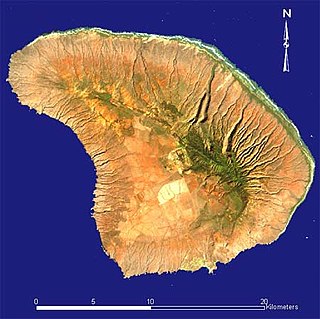
Lanai is the sixth-largest of the Hawaiian Islands and the smallest publicly accessible inhabited island in the chain. It is colloquially known as the Pineapple Island because of its past as an island-wide pineapple plantation. The island's only settlement of note is the small town of Lanai City. As of 2012, the island was 98% owned by Larry Ellison, founder and chairman of Oracle Corporation, with the remaining 2% owned by the state of Hawaii and privately owned homes.

The flag of Hawaii has previously been used by the kingdom, protectorate, republic, and territory of Hawaii. It is the only US state flag to include a foreign country's national flag. The inclusion of the Union Jack of the United Kingdom is a mark of the British Empire's historical relations with the Hawaiian Kingdom, particularly with King Kamehameha I. The flag continued to be used after the 1893 overthrow of the Hawaiian Kingdom.
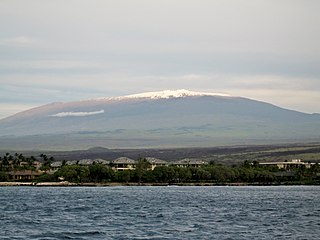
Mauna Kea is a dormant volcano on the island of Hawaiʻi. Its peak is 4,207.3 m (13,803 ft) above sea level, making it the highest point in the state of Hawaiʻi. Most of the volcano is underwater, and when measured from its underwater base, Mauna Kea is the tallest mountain in the world, measuring 10,211 m (33,500 ft) in height. Mauna Kea is about a million years old, and has thus passed the most active shield stage of life hundreds of thousands of years ago. In its current post-shield state, its lava is more viscous, resulting in a steeper profile. Late volcanism has also given it a much rougher appearance than its neighboring volcanoes due to construction of cinder cones, decentralization of its rift zones, glaciation on its peak, and weathering by the prevailing trade winds. Mauna Kea last erupted 6,000 to 4,000 years ago and is now considered dormant. The peak is about 38 m (125 ft) higher than Mauna Loa, its more massive neighbor.
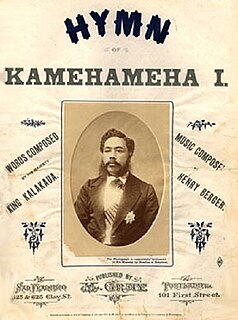
"Hawaiʻi Ponoʻī" is the regional anthem of the U.S. state of Hawaii. It previously served as the national anthem of the independent Kingdom of Hawaii in the 19th Century, and has continued to be Hawaii's official anthem ever since annexation by the United States in 1898.
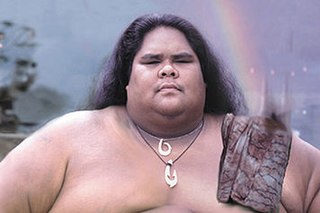
Israel Kaʻanoʻi Kamakawiwoʻole, Hawaiian of the fearless eye, the bold face; May 20, 1959 – June 26, 1997), also called Bruddah Iz or IZ, was a Hawaiian singer-lyricist, musician, and Hawaiian sovereignty activist.

Aloha Stadium is a multi-purpose stadium located in Halawa, Hawaii, a western suburb of Honolulu. It is the largest stadium in the state of Hawaii. Aloha Stadium is home to the University of Hawaiʻi Rainbow Warriors football team.
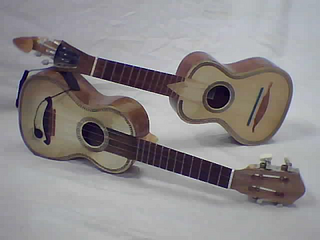
The cavaquinho is a small Portuguese string instrument in the European guitar family, with four wire or gut strings.
Tsat, also known as Utsat, Utset, Hainan Cham, or Huíhuī, is a language spoken by 4,500 Utsul people in Yanglan and Huixin villages near Sanya, Hainan, China. Tsat is a member of the Malayo-Polynesian group within the Austronesian language family, and is one of the Chamic languages originating on the coast of present-day Vietnam.

Poke is diced raw fish served either as an appetizer or as a main course and is one of the main dishes of Native Hawaiian cuisine. Traditional forms are aku and heʻe (octopus). Heʻe (octopus) poke is usually called by its Japanese name tako poke, except in places like the island of Niʻihau where the Hawaiian language is spoken. Increasingly popular ahi poke is made with yellowfin tuna. Adaptations may feature raw salmon or various shellfish as a main ingredient served raw with the common poke seasonings.
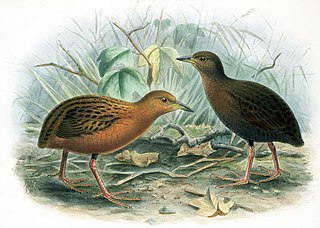
The Hawaiian rail, Hawaiian spotted rail, or Hawaiian crake is an extinct species of diminutive rail that lived on Big Island of Hawaiʻi.

The Hawaiʻi creeper, Hawaii creeper or ʻalawī is a species of Hawaiian honeycreeper endemic to the Big Island of Hawaiʻi. Its natural habitats are dry forests and montane moist forests at elevations of 1,000–2,300 metres (3,300–7,500 ft). There are a total of 12,000 birds separated into three populations. A fourth population on the western part of the island probably represents migratory birds from one of the existing population. The Hawaiʻi creeper measures 4.5 inches (11 cm) and has drab green plumage. In 2017 the traditional Hawaiian name was rediscovered as 'alawi'.
Kekuʻiapoiwa II was a Hawaiian chiefess and the mother of the king Kamehameha I.
Pidgin Hawaiian was a pidgin spoken in Hawaii, which drew most of its vocabulary from the Hawaiian language and could have been influenced by other pidgins of the Pacific region, such as Maritime Polynesian Pidgin. Emerging in the mid-nineteenth century, it was spoken mainly by immigrants to Hawaii, and mostly died out in the early twentieth century, but is still spoken in some Hawaiian communities, especially on the Big Island. Like all pidgins, Pidgin Hawaiian was a fairly rudimentary language, used for immediate communicative purposes by people of diverse language backgrounds, but who were mainly from East and Southeast Asia. As Hawaiian was the main language of the islands in the nineteenth century, most words came from this Polynesian language, though many others contributed to its formation. In the 1890s and afterwards, the increased spread of English favoured the use of an English-based pidgin instead, which, once nativized as the first language of children, developed into a creole which today is misleadingly called Hawaiian 'Pidgin'. This variety has also been influenced by Pidgin Hawaiian; for example in its use of the grammatical marker pau.

High Chiefess Kapiʻolani was an important member of the Hawaiian nobility at the time of the founding of the Kingdom of Hawaiʻi and the arrival of Christian missionaries. One of the first Hawaiians to read and write and sponsor a church, she made a dramatic display of her new faith which made her the subject of a poem by Alfred, Lord Tennyson.

Music of Hawaii is a compilation album containing five 78rpm records of Hawaiian music issued by Decca Records.













